Affiliate links on Android Authority may earn us a commission. Learn more.
Qualcomm Snapdragon 875: What we expect to see

We’re closing in on Qualcomm’s yearly December flagship launch. This year’s chipset is expected to be called the Snapdragon 875, boasting improvements to 5G networking, machine learning capabilities, and a general uplift in performance. The Snapdragon 875 is almost certain to be built on a smaller 5nm manufacturing process for a boost to energy efficiency and silicon area density.
On paper, the 5mn 875 already offers improvements over last year’s Snapdragon 865, and it should sustain its peak performance better than the 865 Plus. But just how much better the new chip will be than its predecessors is the big unknown. Here’s everything we’re expecting from the Snapdragon 875.
See also: Snapdragon SoC guide: All of Qualcomm’s smartphone processors explained
Expected performance improvements
With the Arm CXC program replacing the Build on Arm Cortex initiative, we won’t see tweaked versions of Arm’s Cortex-A CPU cores this generation. Instead, there are just two possible options for this year’s big CPU core — the Cortex-A78 or the Cortex-X1. Provided that Qualcomm is participating in the CXC program this year, of course. A combination of the two is likely a possibility, creating a tri-cluster arrangement to balance performance and power efficiency.
Arm expects that a 5nm 3.0GHz Cortex-A78 can provide a 20% performance improvement over a 7nm 2.6GHz Cortex-A77 core while drawing the same power. Meanwhile, the Cortex-X1 could offer a further 23% improvement over the Cortex-A78 on the same manufacturing process. The X1 is definitely the more powerful core, but it also a bigger, more power-hungry component. A 1+3+4 setup is likely the furthest we’ll see the Snapdragon 875 push performance. Either way, we are expecting to see decent gains with this generation.
Read more: Arm Cortex-X1 and Cortex-A78 CPUs: Big cores with big differences
We know less about the potential graphics and machine learning performance gains from Qualcomm’s in-house Adreno GPU and Hexagon DSP. Typical generational improvements fall into the 20-30% range, although we’ll have to see if 5nm allows for further gains in graphics. Rumored benchmarks suggest overall system performance could jump by as much as 25% with the move to the Snapdragon 875. If true, this suggests notable improvements across the entire chip and impressive results over the already boosted Snapdragon 865 Plus. That would be enough to give Apple’s A14 Bionic a run for its money. There appears to be confidence in the Snapdragon 875’s gaming prowess, as rumors are already buzzing about an ASUS gaming phone partnership.
The existence of the Snapdragon 865 Plus is going to make generational improvement comparisons a little difficult. It’s likely Qualcomm will focus on comparisons to the standard 865 during the 875 launch. Either way, the Snapdragon 875 will be more than capable of handling all of your mobile tasks. What’s yet to be seen is whether the chipset can close the gap on Apple’s laptop ambitions.
Moving beyond the CPU/GPU arms race

While we’re certainly expecting some notable performance gains this generation, we don’t really need any more performance for day-to-day tasks. Recent smartphone chipsets have focused heavily on improvements to machine learning, image processing, computer vision, and networking hardware as well.
We’re almost guaranteed to see further improvements to Qualcomm’s Hexagon DSP and machine learning hardware. Boosts to its Spectra ISP could help it handle advanced photography techniques like real-time video bokeh, object detection, and multi-camera processing. However, we’ll have to wait and see just what in-house improvements the Snapdragon 875 has in store.
We can expect the Snapdragon 875 to offer far than just a performance upgrade.
While we’re on the subject of multi-media, there’s a good chance Qualcomm will improve support for the latest video standards. The ability to record and display 60fps 8K content and even slower motion video may be an option. Support for the upcoming AV1 video codec, augmenting VP9, and HVEC decoding, would be a futureproof addition too.
On the networking side, the existing Bluetooth 5.1 integration could see added support for the new LE Audio codec, in addition to its in-house aptX Bluetooth audio. The chipset is also likely to move on from being Wi-Fi 6 ready to receiving full Wi-Fi 6 support. The addition of Wi-Fi 6E networking is possible as well.
More improvements to 5G

The biggest networking trend in 2020 is the adoption of 5G. Nevertheless, the mass arrival of 5G phones hasn’t quite been the revelation some had hoped. The external Snapdragon X55 modem paired with the Snapdragon 865 has driven up component costs, straining smartphone prices and profit margins. Not to mention exacerbating the 5G power consumption issue. This is why some phone manufacturers turned to the cheaper Snapdragon 765G with an integrated 5G modem.
The move to an integrated 5G modem in the Snapdragon 875 could help improve energy efficiency, costs, and the area taken up inside smartphones. This is arguably the biggest single improvement Qualcomm could make to its premium 5G chipset. Although whether the company has managed to pack all of its cutting-edge 5G features into an integrated modem remains to be seen.
See also: The best 5G phones you can buy right now
Either way, the Snapdragon 875’s 5G capabilities will likely be based on the Snapdragon X60 modem. The Snapdragon X60 introduces high-quality 5G Voice-over-NR (VoNR) capabilities and enhanced carrier aggregation across sub-6GHz and mmWave bands for faster speeds. Peak speeds cap out at 7.5Gbps download and 3Gbps upload. However, real-world results won’t hit those dizzying heights.
The Snapdragon X60 is designed for 5nm manufacturing, resulting in a smaller footprint and lower power consumption than before. It also works with Qualcomm’s latest QTM535 mmWave module and is listed with Dual SIM 5G support, allowing for simultaneous data streams from two SIMs.
What about a Snapdragon 875 Lite?
Rumors also point to a Lite version of Qualcomm’s upcoming Snapdragon chipset. Yet, like all rumors, we should take this with a pinch of salt. Still, there’s precedent. Qualcomm launched the Snapdragon 810 and 808 back in 2014 to cater to market needs.
There is a growing gap between the ultra-premium and mid-range smartphone market. Both in terms of component costs and gaming performance capabilities. A Snapdragon 875 Lite could fit into this hole, cutting out a few high-end features to save costs while still providing better gaming, 5G, and other features that super mid-tier phones clamor for.
See also: Snapdragon 765G vs Snapdragon 865 features and benchmarks
Of course, an update to the Snapdragon 765G could also fit this gap. The 700 series already borrows heavily from the 800 series’ feature set. CPU performance has the majority of apps covered, while 5G, machine learning, and advanced imaging features add a premium touch. Graphics performance is the most glaring difference between the 765G and the 865, as well as the area most ripe for improvement.
We’ll have to see if Qualcomm moves to fill this void with a new 700 series chip or an 875 Lite. Either way, there’s definitely room for another chipset here. But we’ll treat this rumor with caution for now.
What to expect from the Snapdragon 875: The final word

In many ways, the Snapdragon 875 will likely be a simple continuation of Qualcomm’s recent trajectory. Additional peak performance, improved AI and photography capabilities, and a selection of new multimedia features are all on the cards. But these are incremental improvements rather than game-changers for modern hardware.
The Snapdragon 875 will have tough competition in the A14 Bionic and Kirin 9000.
Perhaps more importantly, the 875 should refine this year’s push for 5G networking. The move to 5nm manufacturing, and potentially an integrated 5G modem too, should help reign in power consumption and increase battery life while downloading data over 5G. Along with support for advanced carrier aggregation and Standalone 5G networks, Snapdragon 875 smartphones may help make fifth-gen networking that bit more appealing.
Qualcomm is set to unveil the Snapdragon 875 in the first week of December. After that, it won’t be too long until we can see how the chip performs against the likes of the Apple A14 Bionic and the HUAWEI Kirin 9000.